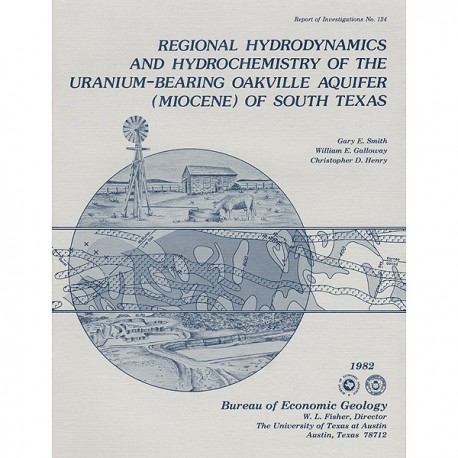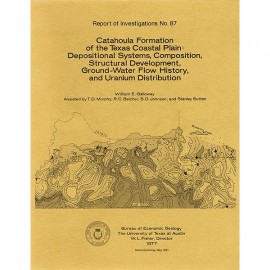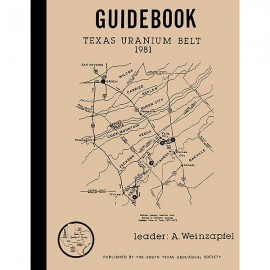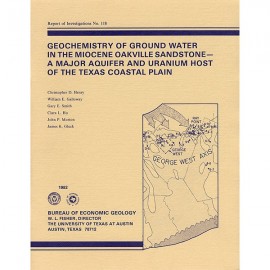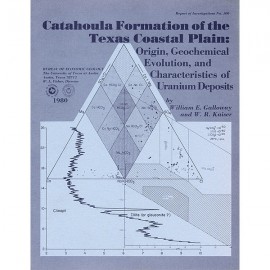Reports of Investigations
-
Books & Reports
- Reports of Investigations
- Guidebooks
- Udden Series
- Geological Circulars
- Down To Earth
- Atlases of Major Oil and Gas Reservoirs
- Texas Memorial Museum Publications
- Environmental Geologic Atlas of the Texas Coastal Zone
- Mineral Resource Circulars
- Other Reports
- Seminars and Workshops
- Handbooks
- Submerged Lands of Texas
- Symposia
- Annual Reports
- Open File Reports
-
Maps & Cross Sections
- Thematic Maps
- Miscellaneous Maps, Charts & Sections
- Geologic Atlas of Texas
- STATEMAP Project Maps
- Geologic Quadrangle Maps
- Cross Sections
- Highway Geology Map
- Energy and Mineral Resource Maps
- Shoreline Change and Other Posters
- Wilcox Group, East Texas, Geological / Hydrological Folios
- Bouguer Gravity Atlas of Texas
- River Basin Regional Studies
- Featured Maps
- Posters
- Teachers & the Public
-
Geological Society Publications
- Gulf Coast Association of Geological Societies
- Alabama Geological Society
- Austin Geological Society
- Corpus Christi Geological Society
- Houston Geological Society
- Lafayette Geological Society
- Mississippi Geological Society
- New Orleans Geological Society
- South Texas Geological Society
- GCS SEPM Publications
- Historic BEG & UT Series
Regional Hydrodynamics and Hydrochemistry of the Uranium-Bearing Oakville Aquifer (Miocene) of South Texas
RI0124
Regional Hydrodynamics and Hydrochemistry of the Uranium-Bearing Oakville Aquifer (Miocene) of South Texas, by G. E. Smith, W. E. Galloway, and C. D. Henry, assisted by J. K. Gluck, J. F. McIntyre, E. T. Pisasale, and S. D. Spradlin. 31 p., 26 figs., 1 table, 1 appendix, 1982. ISSN: 0082335X:Print. Print Version.
A free, digital version of this publication can be found on: Texas ScholarWorks
RI0124. Regional Hydrodynamics and Hydrochemistry of the Uranium-Bearing Oakville Aquifer (Miocene) of South Texas, by G. E. Smith, W. E. Galloway, and C. D. Henry, assisted by J. K. Gluck, J. F. McIntyre, E. T. Pisasale, and S. D. Spradlin. 31 p., 26 figs., 1 table, 1 appendix, 1982. ISSN: 0082335X:Print.
To purchase this publication as a (PDF) download, please order RI0124D.
ABSTRACT
The Oakville Formation consists of sediments deposited by several major fluvial systems that traversed the Texas Coastal Plain during the Miocene Epoch. Facies geometry and composition, together with superimposed structure and topography, are important determinants of ground-water flow, aquifer transmissivity, and regional hydrochemical evolution.
Topographically high areas along the Oakville outcrop are ground-water recharge zones. Downdip movement of ground water is deflected along strike into major incised stream valleys and modified by local ground-water pumping, resulting in discharge of Oakville water from relatively shallow sections of the aquifer. Discharge from local and intermediate-scale flow cells, as well as influx along growth faults of high-salinity water from deeper stratigraphic horizons, is readily shown by field phenomena. Introduction of exotic evolved connate waters is demonstrable by the distribution of sulfate, chloride, and reduced sulfur species. Shallow Oakville ground waters exhibit a clearly defined compositional change from predominantly sodium chloride waters in the southwest to calcium bicarbonate waters in the northeast.
Redox potential (Eh) of Oakville ground water decreases from +470 mV (oxidizing) to -170 mV (reducing) with increasing depth and coincides with an increase in pH and temperature. Dissolved oxygen content exhibits an inverse relationship to Eh and reduced sulfur. Higher recharge in the northeast results in a deeper subsurface penetration of oxygenated ground waters.
The regional distribution of trace amounts of uranium, molybdenum, selenium, and arsenic in Oakville ground water demonstrates a good correlation with known sites of uranium mineralization, and defines elevated trace metal contents unrelated to known uranium occurrences. These same elements exhibit an overall increased background level in the southwestern section of the study area.
Keywords: hydrochemistry, hydrodynamics, Miocene, Oakville Formation, trace metals, stratigraphy, transmissivity, uranium, South Texas, Texas Coastal Plain
CONTENTS
ABSTRACT
INTRODUCTION
PHYSICAL STRATIGRAPHY
HYDRODYNAMICS
Recharge and discharge
Regional temperature gradients
HYDROCHEMISTRY
Major components
Total dissolved solids
Bicarbonate
Sulfate and chloride
Sodium and calcium
Hydrochemical facies
Electrochemical parameters
Trace metals
Uranium, molybdenum, and selenium
Arsenic and copper
Iron and manganese
CONCLUSIONS
ACKNOWLEDGMENTS
REFERENCES
APPENDIX
Figures
1. Location map of study area
2. Depositional elements of the Oakville Formation
3. Regional transmissivity of the Oakville aquifer
4. Regional hydraulic head within the Oakville Formation
5. Topographic relief along the Oakville outcrop belt
6. Differences in hydraulic head versus elevation
7. Distribution of field phenomena and regional recharge-discharge zones
8. Ground·water temperatures within the Oakville aquifer
9. Total dissolved solids content of Oakville ground water
10. Bicarbonate content of Oakville ground water
11. Sulfate content of Oakville ground water
12. Chloride content of Oakville ground water
13. Sodium-to-calcium ratio of Oakville water
14. Hydrochemical fades patterns within the Oakville aquifer
15. Oxidation potential of Oakville ground water
16. Distribution of dissolved oxygen in Oakville ground water
17. Content of reduced sulfur species in Oakville water
18. Hydrogen ion potentials in Oakville ground water
19. Uranium distribution in Oakville ground water
20. Uranium content as a function of Eh and pH
21. Molybdenum distribution in Oakville ground water
22. Selenium distribution in Oakville ground water
23. Arsenic distribution in Oakville ground water
24. Copper distribution in Oakville ground water
25. Iron distribution in Oakville ground water
26. Manganese distribution in Oakville ground water
Table
1. Summary of vertical hydraulic gradient data
Citation
Smith, G. E., Galloway, W. E., and Henry, C. D., 1982, Regional Hydrodynamics and Hydrochemistry of the Uranium-Bearing Oakville Aquifer (Miocene) of South Texas: The University of Texas at Austin, Bureau of Economic Geology Report of Investigations No. 124, 31 p.
